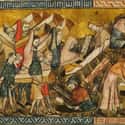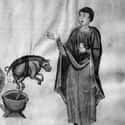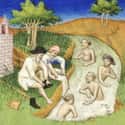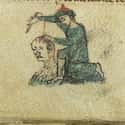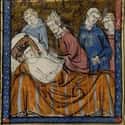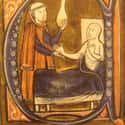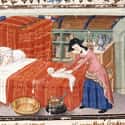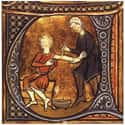-
(#1) Leprosy
- Disease or medical condition
Caused by the Mycobacterium leprae bacteria, leprosy is, arguably, as misunderstood today as it was during the Middle Ages. Now called Hansen's Disease, leprosy results in skin lesions and nerve damage that can impair a person's eyes and limbs. Leprosy develops slowly, and visible symptoms can take decades to manifest.
In medieval society, lepers were shunned and cast out of cities, towns, villages, and even the smallest of communities. Leper hospitals were established outside of town centers during the 12th century in France and the Low Countries. Facilities tasked to solely care for lepers were known as leprosaria (or leprosariums) and fell under the charitable auspices of the Church.
Leprosy was common in both the Byzantine Empire and Western Europe from the 12th century forward, often transferred by pilgrims and Crusaders. Lepers were refused burial alongside non-lepers thanks to the Old Testament passage Leviticus 13:44-46:
He is leprous, he is unclean. The priest shall pronounce him unclean; the disease is on his head. The person who has the leprous disease shall wear torn clothes and let the hair of his head be disheveled; and he shall cover his upper lip and cry out, “Unclean, unclean.” He shall remain unclean as long as he has the disease; he is unclean. He shall live alone; his dwelling shall be outside the camp.
The social class of the leper dictated their overall reception, however. Alice the Leper, a lay sister from the Cistercian monastic order, remains the patron saint of the blind and the paralyzed after becoming both due to her leprosy.
-
(#2) Bubonic plague
- Disease or medical condition
The Black Plague spread from Asia into Europe during the mid-14th century, resulting in millions of casualties in the process. No one was immune from the Black Plague, a general term for the three different types of plague caused by the Yersinia pestis bacteria. Most commonly spread by infected fleas carried on cargo ships, the plague could manifest in bubonic, pneumonic, and septicemic forms.
The bubonic plague affected one's lymphatic system, causing swelling and discoloration of the areas around the lymph nodes - known as buboes. The pneumonic plague infiltrated the lungs, while the septicemic plague resulted when the bacteria entered an individual's bloodstream. The pneumonic was the most dangerous and infectious because it could be transmitted through airborne blood droplets.
According to 14th-century Italian poet Giovanni Boccaccio, the plague affected "men and women alike... at the beginning of the malady, certain swellings, either on the groin or under the armpits… waxed to the bigness of a common apple, others to the size of an egg, some more and some less, and these the vulgar named plague-boils.”
Other symptoms included fever, vomiting, body aches, and, more than 50% of the time, loss of life. The Black Plague terrified everyone:
One citizen avoided another, hardly any neighbour troubled about others, relatives never or hardly ever visited each other. Moreover, such terror was struck into the hearts of men and women by this calamity, that brother abandoned brother, and the uncle his nephew, and the sister her brother, and very often the wife her husband. What is even worse and nearly incredible is that fathers and mothers refused to see and tend their children, as if they had not been theirs.
There were so many cadavers in many medieval towns and cities that they reportedly "[f]illed every corner... Although the cemeteries were full they were forced to dig huge trenches, where they buried the bodies by hundreds."
-
(#3) St. Anthony's Fire
St. Anthony's Fire, caused by eating grains contaminated with the Claviceps purpurea fungus, is also known as ergotism. The ergot fungus grows on moldy grains and, once ingested, can cause redness, swelling, and gangrene. Rye was produced and consumed in large quantities by the poor and was especially susceptible to the ergot fungus, so the disease affected the lower classes in the greatest numbers.
When one is first struck with St. Anthony's Fire, red spots appeared on the flesh. The initial burning soon becomes excruciating as limbs swell; people often hallucinate, with some in the past believing they were in a fight with the devil. Sometimes, people have convulsions, but as their extremities begin to rot, toes, fingers, ears, and even arms or legs can fall off. Based on an account of the St. Antony's Fire outbreak that struck southern France during the 10th century:
The afflicted thronged to the churches and invoked the saints. The cries of those in pain and the shedding of burned-up limbs alike excited pity; the stench of rotten flesh was unbearable.
In 944 CE, 40,000 people in France perished from St. Anthony's Fire, and monastic hospitals were built throughout Europe to treat victims.
-
(#4) Sweating Sickness
Largely associated with England, "sweating sickness" appeared several times from 1485 to the late 16th century. In 1485 alone, sweating sickness took the lives of 15,000 people in London. After the initial onslaught of the disease, it faded until 1508 and reappeared again in 1517. The sweating sickness jumped to Continental Europe and struck Flanders, Germany, Sweden, and several other locations during the 1520s before it reemerged in England for the last time in 1551.
The initial symptoms of the sweating sickness were "a sense of apprehension" followed by headaches, pain in one's back and shoulders, and nausea. This was followed by excessive sweating, delirium, and abdominal pain. The more severe symptoms lasted anywhere from 15 to 21 hours and accompanied extreme fatigue which could result in a coma or loss of life.
The sweating sickness mostly affected the upper class and could end the life of an adult in a matter of hours. During the outbreak of 1529, King Henry VIII so feared getting the disease that he "left in great haste, and went a dozen miles off" to hide from the affliction.
Researchers have theorized that the sweating sickness was caused by typhus, influenza, botulism, or the hantavirus, but no definitive source of the disease has been found.
-
(#5) Tuberculosis
- Disease or medical condition
Called the "white plague," "consumption," or "king's evil" during the Middle Ages, symptoms of tuberculosis include a fever and persistent coughing that can result in expressing white phlegm or blood. When the lymph nodes in one's neck become enlarged, the disease is also called scrofula.
Tuberculosis was believed to be contagious, but there were assertions that royalty could cure the disease with a simple touch. As early as the 11th century, King Edward the Confessor in England and Philip I in France conducted ceremonies to touch individuals suffering from scrofula. Those afflicted and touched received "touchpieces," or gold coin amulets, signifying the event.
Tuberculosis mostly afflicted poor town dwellers living in less than hygienic conditions.
-
(#6) Dysentery
Also known as "the flux," dysentery was endemic during the Middle Ages, common in medieval towns, cities, villages, monasteries, and among groups of soldiers. Dysentery results from bacteria or parasites in water or contaminated food and causes bloody diarrhea, fever, and dehydration.
St. Martin, Bishop of Tours (d. 397 CE), described his own bout with the disease as so bad that he "completely gave up any hope of living."
The cause of dysentery was generally unknown during the Middle Ages. During the 13th century, Arnau of Vilanova recounted the case of a youth who had "uncontrolled dysentery" and was asked by his physician where he got his food and water. The boy responded he got water from a stone cistern. The doctor advised him to stop drinking what he believed was "calcinated water" resulting from the stone and cement that lined the cistern. He supposedly quickly recovered after he stopped drinking the water.
We know now that "calcinated water" was not the problem, but because the doctor inadvertently stopped him from drinking from a tainted water source, he did improve. In another instance, however, the disease was attributed incorrectly and the physician's advice had no effect on the patient; Vilanova mentioned an open roof allowed the wind to bring in dysentery.
Generally, no one was safe, a fact 15th-century Italian polymath Girolamo Savonarola made clear when he observed that pestilential dysentery affected "not only in the same house but also in an entire locale, and with [the affliction] moving from a child of ten or fifteen to a sexagenarian." Savonarola himself came down with dysentery in 1495.
-
(#7) Bacterial Infection
Communal living during the Middle Ages made the transmission of disease and infection particularly troublesome. In medieval hospitals, infection was common due to a lack of cleanliness. Patients often suffered due to the prevailing "laudable pus" theory. Physicians believed that pus was a good sign and necessary for healing. If pus didn't appear, a doctor might find ways to produce by digging at the damaged area or finding another way to produce an abscess.
Not all doctors favored manipulating things to the point of abscess, however. Henri de Mondeville, a 13th and 14th century French surgeon, advocated for cleanliness and the closing of gashes and cuts as opposed to letting them openly fester. Mondeville even went so far as to recommend using wine as a disinfectant.
-
(#8) Syphilis
- Disease or medical condition
The origins of syphilis remain contested, but by the late 15th century, the disease had hit Europe. In 1495, French soldiers were said to have contracted the disease during the siege of Naples, where it may have been widespread since as early as 1429. Spanish physician and scholar Gaspar Torella wrote about syphilis in the 1490s, describing the ulcers and swelling that could afflict one's genitals before other pains, pustules, and maladies appeared. He dedicated the work to Cesare Borgia (1475-1507), a Valencian military leader and statesman, because it was Borgia's affliction that brought the disease to light for the doctor.
Borgia may have contracted syphilis from a sex worker he visited in 1497. There are theories that Borgia perished of the disease, and he certainly demonstrated physical symptoms, described by a contemporary in 1504 as having a face that "was ravaged and blotched."
-
(#9) Pneumonia
Both pneumonia and pleurisy were common during the Middle Ages, and once the writings of Galen were translated into Latin during the 5th century, distinguishing between the two conditions became more clear. According to Galen's Therapeutics to Glaucon, both pneumonia and pleurisy were respiratory diseases, but the former presented with a fever, difficulty breathing, and chest pain.
Some individuals showed signs of redness and had difficulty laying down, often attributed to "humor in the lungs." In contrast, pleurisy also included chest pain, but the discomfort could radiate through the shoulders and down into one's groin. Both afflictions could result in coughing up blood. The important distinction was that pneumonia could lead to pleurisy, but the latter could also result from traumatic damage as well. Treatments for both were determined based on the cause.
Galen's contributions to understanding pneumonia were taken up by 12th-century philosopher and writer Moses Maimonides. He described the symptoms of pneumonia as "acute fever, sticking [pleruitic] pain in the side, short rapid breaths, serrated pulse and cough, mostly associated with sputum."
Being able to identify pneumonia made the plague outbreak of the 14th century more complicated, however. When individuals exhibited the symptoms associated with pneumonia, it was assumed they had the more dangerous of the two diseases. According to historian Ole Jorgen Benedictow, plague patients often coughed up blood regardless of what type of plague they had, making it difficult to assess how many cases of pneumonic plague truly presented themselves during the 14th century.
-
(#10) Smallpox
- Disease or medical condition
Smallpox declined during the Middle Ages, but it did not disappear. As a disease that had been around for millennia, a portion of the population built up an immunity by the 14th century. As early as the 9th century, Islamic scholar Abu Bakr Muhammad ibn Zakariyya al-Razi (865-925 CE) wrote a medical treatise on smallpox and measles, describing symptoms and treatments for both.
Al-Razi was fundamental in distinguishing between the two diseases, which had previously been lumped under the larger category of rashes. He determined that measles was not as serious as smallpox and that they had different causes. Al-Razi described the symptoms of smallpox as fever, back pain, and restless sleep. A person would feel swollen and their skin would be inflamed, similar to how the measles would manifest, but the latter often included headache and nausea.
Smallpox, on the other hand, involved lethargy, throat pain, and thick throat saliva that could effect breathing and speaking. Al-Razi believed the best way to treat smallpox pustules was to wrap, rub, steam, purge, and bleed the afflicted individual.
-
(#11) Arthritis
Evidence of arthritis has been found in skeletons from the medieval period, and several descriptions of the affliction can be found in medieval texts. Thirteenth-century Franciscan encyclopedist Bartolomaeus Anglicus called arthritis "an ache and disease in the fingers and toes with swelling and pain" and said arthritis was the result of "the age of the patient and the region in which he lives and from the climate."
As he suffered from joint inflammation of his own, he lamented:
One form of the disease is worse for it makes the fingers shrink and shrivels the toes and sinews of the feet and of the hands. This form... makes the hands dry and crooked and closed and incapable of being opened. Also it makes the joints of the fingers unsightly with knotty bunches and this sickness must be treated soon, for when it is old it is only curable with difficulty.
-
(#12) Infant Mortality
There were a lot of diseases that could shorten one's life during the Middle Ages, and infants and children were particularly vulnerable. Whooping cough and diphtheria were more prevalent in young populations, especially in towns and cities. In Scotland, the remains from one Aberdeen cemetery revealed 53% of the buried individuals were under the age of 6, while in Linlithgow, it was 58%.
Some historians estimate infant mortality during the Middle Ages was as high as 30 to 50%, while others believe 20% is a more accurate figure. That said, it's difficult to get a clear assessment of stillborns and infant mortality. Infant's bones decay more quickly than their adult counterparts, and if an infant was not baptized prior to burial, it would not have been buried in a Christian cemetery.
Diseases weren't the only causes of infant mortality. Iron deficiency, often the result of extended breastfeeding, was common. This could contribute to poor health for women and their children alike. Additionally, bleeding during childbirth or a miscarriage could further weaken a woman with anemia.
-
(#13) Unbalanced Humours
Any unexplained ailment, and even one that could be explained, was often attributed to unbalanced humours. Medieval physicians sought to balance the four humours - blood, phlegm, choler (or yellow bile), and melancholy (or black bile). These humours had physical qualities that dictated the mind and body, and when one was out of balance, it led to disease. The principle dated back to Greek medicine and called for methods to bring about equilibrium. Diet, climate, exercise, herbal remedies, purges, and bloodletting could be used to rebalance humours.
Balancing one's humors could be preventative or therapeutic. Bloodletting, for example, could be carried out according to a calendar. Humours corresponded to different seasons, making their seasonal importance that much more acute. As far as treatment, bloodletting was used for everything from the bubonic plague to gout. Once clergy men were prohibited from participating in bloodletting in 1163, professional barber-surgeons began bleeding people instead.
New Random Displays Display All By Ranking
About This Tool
The Middle Ages was called the Dark Age for no reason. People at that time were indeed living in fear, especially the poor, who faced constant religious wars and deadly infectious diseases. In the mid-fourteenth century, a plague swept across Europe, killing tens of millions of people, and reducing the population of Europe by one-third. That plague was also called the Black Death.
Many infectious diseases had even regularly repeated outbreaks, common diseases were malaria, diphtheria, flu, smallpox, and leprosy in the Middle Ages, which caused more deaths than ever. The random tool lists 13 dangerous infectious diseases you might suffer in a Medieval city.
Our data comes from Ranker, If you want to participate in the ranking of items displayed on this page, please click here.












